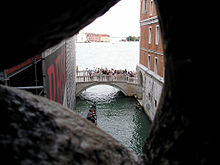Bridge of Sighs


The Bridge of Sighs (Italian: Ponte dei Sospiri) is a small bridge in Venice, northern Italy. The bridge has walls and a roof. It is made of white limestone and has windows with stone bars. It passes over the Rio di Palazzo and connects the old prisons to the interrogation rooms in the Doge's Palace. It was designed by Antoni Contino (whose uncle Antonio da Ponte had designed the Rialto Bridge), and built in 1602.
The view from the windows of the Bridge of Sighs was the last view of Venice that convicts saw before their imprisonment. The bridge was named by Lord Byron in the 19th century. It was thought that prisoners would sigh at their final view of beautiful Venice through the windows before being taken down to their cells. In reality, the days of inquisitions and summary executions were over by the time the bridge was built and the cells under the palace roof were occupied mostly by small-time criminals. In addition, little could be seen from inside the Bridge due to the stone grills covering the windows.
A local legend says that lovers will be granted everlasting love and bliss if they kiss on a gondola at sunset under the bridge.[1]
Alternative (more likely) factual history
[change | change source]Most civilizations change the meaning of events and objects later to make the current group in control have a more pleasant history or to take a common negative representation and just tell a new story that is more positive. For example the ancient Roman Lady Justice did not contain a blindfold so she could correctly see the actions of humans to make a fair judgement and usually the scales were balanced to represent the final outcome after punishment with her sword against the wrongdoer, but an American artist trying to point out the unfairness in the United States Court system sculpted a Lady Justice that it is blind to the injustice of the poor and the scales were not balanced but tilted toward one side, the side of the rich; the criticism being that the court system does not accurately see the facts and the end result is usually not balanced and fair. However, after the statue gained a lot of publicity and the court system rightfully criticized, the people in power started to just make up a new meaning ... that the blindfold means the justice system does not see who comes into the court (supposedly unbiased) and the unbalanced scales show the legal system attempts to re-balance the scales (or new statues just return to balanced scales). If you do not like your history or a criticism, then just change it.
The Bridge Of Sighs connects that room where the authority determined the legal fate of people and the rooms of the jail and torture places (although the most severe religious torture was mostly gone by the time the bridge was created, there is still plenty of documentary evidence of occasional torture). Because both the poor (who mostly were illiterate) and the rich (who often were literate) were put before the government for punishment, there are letters of the rich (nobles) who wrote to family saying that it was common for wives and family to stand so they could see the Bridge of Sighs hoping to get a last view of their loved one before torture or prison sentence being taken upon them. Likely the prisoners also sighed passing the windows knowing this may be the last time they would see their loved ones. Even though this is likely a more accurate history of the common usage of Bridge of Sighs even before published by Lord Byron, it is simple to understand how the people in power would want to change the meaning to something more positive. But think about the main reason people walk this bridge (torture, prison, loss of wealth) and the water-level bridge where family likely stood in front of the prison bridge windows and decide what is more logical and likely. Did the prisoners and family on the water-level bridge loudly sigh due to the beauty of the view OR the fear of pain and loss of love?
Related pages
[change | change source]The name "Bridge of Sighs" has since been applied by association to other similar covered bridges around the world, including:
- Puente de los Suspiros ("Bridge of Sighs" in Spanish), a bridge in the city of Barranco, Lima, Peru
- Bridge of Sighs (Cambridge)
- Bridge of Sighs (Oxford)
- Långholmsbron, a bridge in Stockholm, Sweden
- A bridge at the Römer (Frankfurt am Main)
- A bridge in the Santa Barbara County Courthouse, Santa Barbara, California
- Two bridges in Budapest, Hungary
- The Virginia Street Bridge in Reno, Nevada, known for being the place where newly-divorced women coming from the Washoe County Courthouse would toss their wedding rings into the Truckee River
- It was the inspiration for a bridge built in 1884 between the Allegheny County Courthouse and the old county jail in downtown Pittsburgh, USA. It has been deemed a National Historic Landmark.
- One of the few natural arches in the Grand Canyon that is visible from the Colorado River (at mile 35.6, about 57.3 km on the right). It is located in Redwall limestone and has a span of 4 metres (15 feet) and a height of 9 metres (30 feet).
In fiction
[change | change source]- A reproduction of the bridge is featured in Volume 1 of the science fiction manga Aria, by Kozue Amano.
References
[change | change source]- ↑ "Ponte dei Sospiri (the Bridge of Sighs)". travelandleisure.com.
